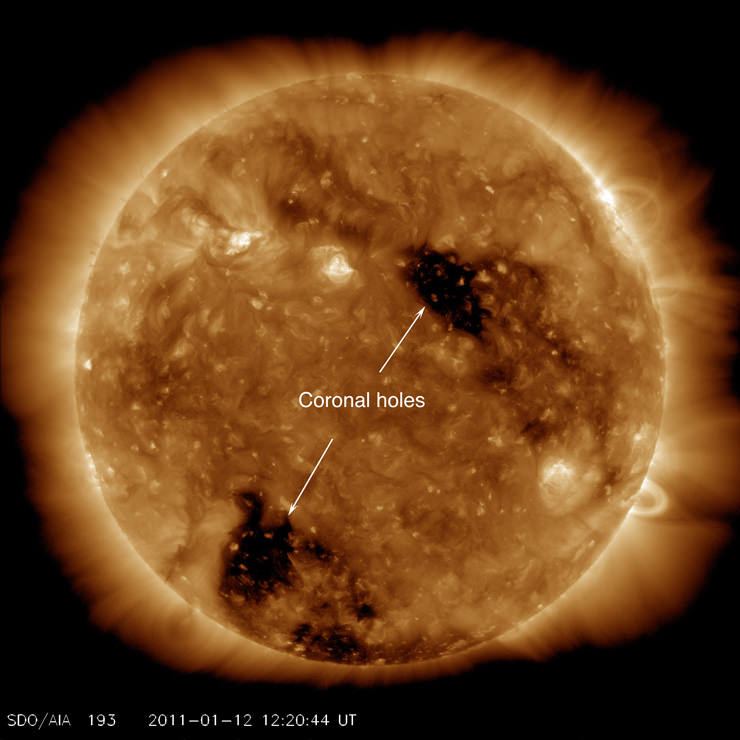[/caption]
A pair of coronal holes on the Sun newly imaged by NASA's flagship solar probe, the Solar Dynamics Observatory (SDO) may cause auroral activity here on Earth soon.
The pair of holes were captured in images taken from Jan 9-12, 2011 by SDO's AIA instrument in the extreme untraviolet (UV). The images - shown above and below - were also made into a cool timelapse video (shown below) of the rotating sun and were released by
NASA
as "SDO Pick of the Week" for Jan. 14, 2011.
SDO research results on the solar corona are featured as the cover photo and story for the current issue of Science magazine on Jan. 7, 2011.
Updated
[caption id="attachment_82581" align="alignleft" width="196" caption="Science magazine Jan. 7 2011, COVER. Multiwavelength extreme ultraviolet image of the Sun taken by the Solar Dynamics Observatory's Atmospheric Imaging Assembly. Colors represent different gas temperatures: ~800,000 kelvin (K) (blue), ~1.3 million K (green), and ~2 million K (red). New observations reveal a link between hot plasma and jets propelled upward from the region immediately above the Sun's surface and help explain why the Sun's outer atmosphere, or corona, is much hotter than its surface. Image: NASA/Solar Dynamics Observatory/Atmospheric Imaging Assembly (AIA) Click to enlarge all images"]
[/caption] Coronal holes on the
sun's
surface are the source of open magnetic field lines and are areas from which high-speed solar wind particles stream out into space. The fast solar wind travels at approximately 800 km/s (about 1.8 million mph). After traveling through space for a few days the particles will impact the Earth and may spark the formation of some auroral activity for lucky spectators.
The two holes developed over several days. In a video
here
, one hole is above the suns equator and the other is below. According to a NASA press release, the coronal holes appear dark at the extreme UV wavelength of 193 Angstroms because there is just less of the material – ionized iron- that is being imaged.
2 D Video: A Hole in the Sun's Corona
Caption: This timelapse video shows a coronal hole, as captured in ultraviolet light by NASA's Solar Dynamics Observatory around Jan. 10, 2011. Coronal holes are areas of the sun's surface that are the source of open magnetic field lines that head way out into space. They are also the source regions of the fast solar wind, which "blows" at a relatively steady clip of 1.8 million mph. (No audio). Credit: NASA
3 D Video: Coronal holes from STEREO
Check out this 3 D movie of a coronal hole snapped by NASA's twin STEREO solar probes orbiting the sun. You'll need to pull out your red-cyan 3 D anaglyph glasses. First, watch the short movie with you 3 D glasses. Then, I suggest to pause the movie at several intervals for a longer look. Remember – its red on the left eye.
View more 3 D from SDO below. And enjoy more
3 D space imagery here - at a big Martian crater
through the eyes of the Opportunity rover.
Caption: This STEREO image features an active region and a coronal hole. The hole is the large dark spot in the middle of the sun. Coronal holes are the source of solar wind and a generator for space weather activity. Credit: NASA
More at this NASA
press release
SDO roared to space on February 11, 2010 atop a powerful Atlas V rocket from Cape Canaveral Air Force Station in Florida. Launch photo below.
The billion dollar probe is the "crown jewel" in NASA's solar fleet and will soon celebrate its first anniversary in space. SDO's mission is to explore the Sun and its complex interior mechanisms in unprecedented detail. It is equipped with three science instruments (HMI, AIA, and EVE)
[caption id="attachment_82578" align="aligncenter" width="580" caption="This Solar Dynamics Observatory image of the Sun taken on January 10, 2011 in extreme ultraviolet light captures a dark coronal hole just about at sun center. Coronal holes are areas of the Sun's surface that are the source of open magnetic field lines that head way out into space. Credit: NASA"]
[/caption]
[caption id="attachment_82580" align="aligncenter" width="386" caption="SDO blast off on Feb. 11, 2010 atop Atlas V rocket from Pad 41 at Cape Canaveral as viewed from the KSC press site. Credit: Ken Kremer"]
[/caption]
[caption id="attachment_82598" align="aligncenter" width="580" caption="Solar 3 D in Extreme UV - from SDO.
This 3 D image was created by combined two images that were taken in one extreme UV wavelength about 8 hours apart on June 25, 2010. The Sun's rotation created enough of a perspective change for this to work. Although the SDO mission cannot produce true 3D images of the Sun like STEREO, 3D solar images can still be made from SDO images. Credit: NASA/SDO"]
[/caption]
 Universe Today
Universe Today
